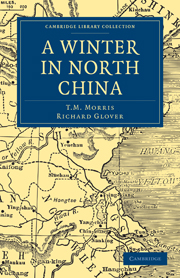Book contents
- Frontmatter
- INTRODUCTION
- AUTHOR'S PREFACE
- MAP OF THAT PART OF CHINA VISITED BY DR. GLOVER AND THE REV. T. M. MORRIS.
- Contents
- CHAPTER I FROM SAN FRANCISCO TO YOKOHAMA
- CHAPTER II CHEFOO AND TIEN-TSIN
- CHAPTER III FROM TIEN-TSIN TO TSING-CHOW-FU
- CHAPTER IV TSING-CHOW-FU
- CHAPTER V CHOW-PING
- CHAPTER VI CHI-NAN-FU
- CHAPTER VII THE GREAT PLAIN OF CHINA
- CHAPTER VIII T'AI-YUEN-FU
- CHAPTER IX PEKING
- CHAPTER X AN INTERVIEW WITH LI-HUNG-CHANG
- CHAPTER XI SHANGHAI
- CHAPTER XII HANKOW, HONG-KONG, AND CANTON
- CHAPTER XIII THE RELIGIONS OF CHINA
- CHAPTER XIV FUNG-SHUI
- CHAPTER XV MISSIONARY WORK AND METHODS IN CHINA
- APPENDIX
CHAPTER III - FROM TIEN-TSIN TO TSING-CHOW-FU
Published online by Cambridge University Press: 05 August 2011
- Frontmatter
- INTRODUCTION
- AUTHOR'S PREFACE
- MAP OF THAT PART OF CHINA VISITED BY DR. GLOVER AND THE REV. T. M. MORRIS.
- Contents
- CHAPTER I FROM SAN FRANCISCO TO YOKOHAMA
- CHAPTER II CHEFOO AND TIEN-TSIN
- CHAPTER III FROM TIEN-TSIN TO TSING-CHOW-FU
- CHAPTER IV TSING-CHOW-FU
- CHAPTER V CHOW-PING
- CHAPTER VI CHI-NAN-FU
- CHAPTER VII THE GREAT PLAIN OF CHINA
- CHAPTER VIII T'AI-YUEN-FU
- CHAPTER IX PEKING
- CHAPTER X AN INTERVIEW WITH LI-HUNG-CHANG
- CHAPTER XI SHANGHAI
- CHAPTER XII HANKOW, HONG-KONG, AND CANTON
- CHAPTER XIII THE RELIGIONS OF CHINA
- CHAPTER XIV FUNG-SHUI
- CHAPTER XV MISSIONARY WORK AND METHODS IN CHINA
- APPENDIX
Summary
In prospect of this long journey, and with the view of minimizing our fatigue and discomfort, our friends made great endeavours to secure for us mule-litters, or shent-zus, as they are called here; but they are not used in Chih-li, and none happening to be in the city when we wanted them, we were, as some one said, condemned to the cart.
Now, the Chinese or Peking cart, while a very venerable and respectable institution, is, regarded as a mode of conveyance, neither commodious nor luxurious. It is a small but very heavy and strong tilted cart on two wheels; the whole conveyance is built of very strong, tough wood, the wheels heavily tyred with iron, and further protected on the outside with iron bosses; the axle-tree is of large dimensions and great strength, and the axle projects on each side of the cart some six or seven inches. On the bottom of the cart there are several wooden projections, fitting the axle-tree, so that it can be put forward or back-ward according to the load carried—the same principle as in an English dog-cart, though the altered position is secured by lifting instead of a screw—and the body of the cart, when got into position, is secured to the axle-tree by strong ropes; the shafts run through the cart, so as to form the support of a rack in the rear, on which heavy luggage can be placed, and to stop the cart at a convenient angle when it is tilted up in the inn yard or elsewhere.
- Type
- Chapter
- Information
- A Winter in North China , pp. 56 - 64Publisher: Cambridge University PressPrint publication year: 2010First published in: 1892



